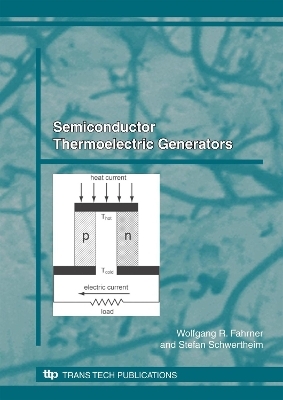
Semiconductor Thermoelectric Generators
Trans Tech Publications Ltd (Verlag)
978-0-87849-152-0 (ISBN)
- Keine Verlagsinformationen verfügbar
- Artikel merken
It is well-known that fossil fuels are being rapidly depleted, and that atomic power is rejected by many people. As a consequence, there is a strong trend towards alternative sources such as wind, photovoltaics, solar heat and biomass. Strangely enough, quite another power source is generally neglected: namely, the thermoelectric generator (a device which converts heat, i.e. thermal energy, directly into electrical energy). The reason for this neglect is probably the low conversion efficiency, which is of the order of a few percent at most. However, there are two arguments in favor of the thermoelectric generator. Firstly, we might in effect be at the same point as we were in the early stages of photovoltaics use (it was only in 1954 that the first attractive solar cells, with efficiencies of around 4% were produced). Today, even large modules attain 20%. Secondly, the potential applications of thermoelectric generators are very tempting. Wherever heat is generated, it is amenable to electrical conversion. Energy harvesting via a thermoelectric generator may be accompanied by a further benefit: The use of a solar module inevitably leads to a drastic temperature rise. A thermoelectric generator reduces the temperature rise and therefore offers a double benefit.
Preface
Contents
1 Introduction
2 Historical Background
2.1 The discovery of the thermoelectric effect by Thomas Johann Seebeck
2.2 Historical development of the thermogenerator
3 Basic Principles
3.1 The Seebeck effect
3.2 Characterization of thermoelectric generators
4 Materials and Technology of Thermogenerators
4.1 Thermogenerators as produced with thin film technology
4.2 Thermogenerators as produced with thick film technology
5 Measurement Techniques
5.1 Measurement of the Seebeck coefficient
5.2 Measurement of the Thermal Conductivity
5.3 Four Point Measurement of the Electric Conductivity
6 Cascadation and Segmentation
6.1 Temperature Dependency of the Figure of Merit
6.2 Segmented and cascaded thermogenerators
7 New Concepts
7.1 Nanomaterials
7.2 Industrial concepts
8 Condensed Literature Research
8.1 Micro / nanothermogenerators
8.2 Superlattice thin film thermogenerators
8.3 Thermogenerator of layers deposited by electroplating
9 Condensed Patent Research
9.1 Thin film thermogenerators
9.2 Thick film thermogenerators
10 Future Perspectives, Applications and Markets for Thermoelectrics
10.1 Future perspectives of thermoelectrics
10.2 The patent situation of thermoelectrics
10.3 Applications of Thermoelectrics
10.4 Companies and markets for thermoelectrics
11 Literature
12 Acknowledgments
13 List of Acronyms, Abbreviations and Symbols
Physical Symbols
Relevant Chemical Symbols
| Reihe/Serie | Materials Science Foundations |
|---|---|
| Zusatzinfo | Illustrations, unspecified |
| Verlagsort | Zurich |
| Sprache | englisch |
| Maße | 170 x 240 mm |
| Gewicht | 500 g |
| Themenwelt | Technik ► Elektrotechnik / Energietechnik |
| ISBN-10 | 0-87849-152-X / 087849152X |
| ISBN-13 | 978-0-87849-152-0 / 9780878491520 |
| Zustand | Neuware |
| Haben Sie eine Frage zum Produkt? |
aus dem Bereich


